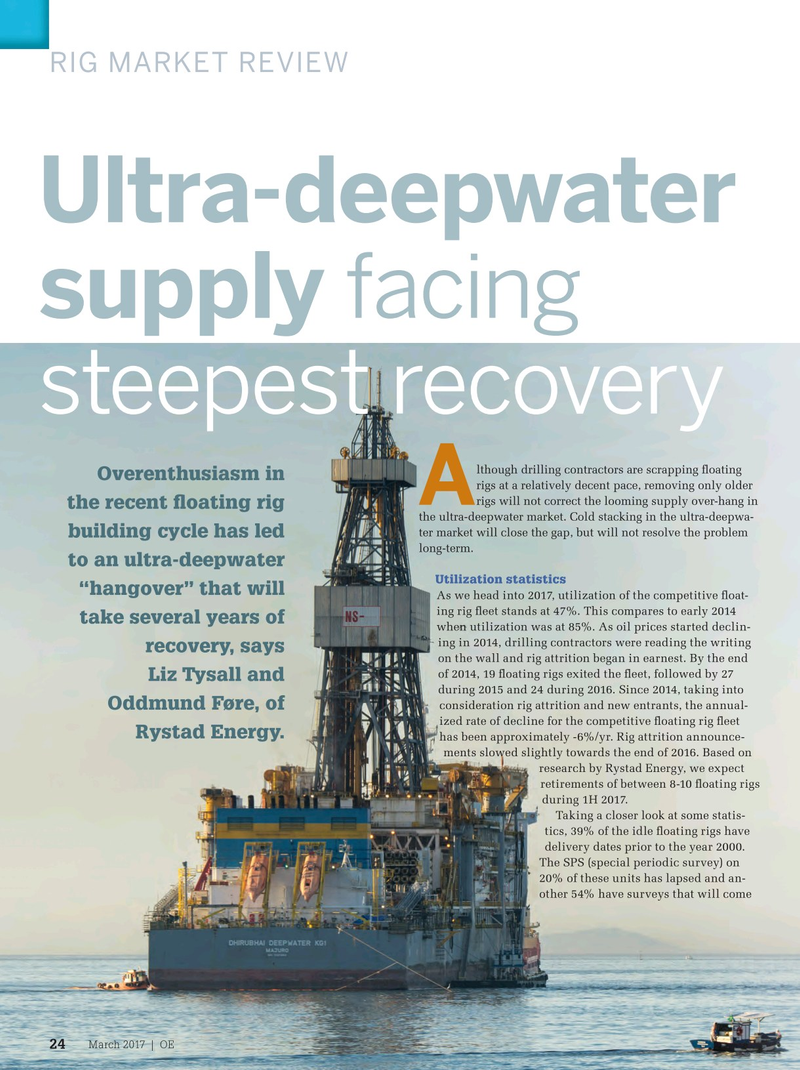
Page 22: of Offshore Engineer Magazine (Mar/Apr 2017)
Read this page in Pdf, Flash or Html5 edition of Mar/Apr 2017 Offshore Engineer Magazine
RIG MARKET REVIEW 16-20 years 0-5 years 6-10 years11-15 years 26-30 years 21-25 years 31-35 years36 years+ 100% 75% 50%
Ultra-deepwater 25% 0% 201420152016201720182019 facing supply
Source: Rystad Energy RigCube due during either 2017 or 2018. For those units with surveys coming due within the next two years, only seven are ultra- deepwater. Of the remaining units, nine are deepwater and 13 steepest recovery are midwater.
Re-shaping the ? oating rig ? eet lthough drilling contractors are scrapping ? oating Setting aside SPS due dates, hypothetically, if only units
Overenthusiasm in rigs at a relatively decent pace, removing only older that were 25+ years old were removed during 2017 and all
A rigs will not correct the looming supply over-hang in newbuilds (excluding Brazilian newbuilds) scheduled for the recent ? oating rig the ultra-deepwater market. Cold stacking in the ultra-deepwa- delivery entered, this would bring the 2017 competitive ? eet ter market will close the gap, but will not resolve the problem down to 205 units. Which is closer to levels seen just prior building cycle has led long-term. to 2010. Removal of these units changes the composition of to an ultra-deepwater the ? eet into 13 midwater units, 12 deepwater units and 180
Utilization statistics ultra-deepwater units. While this is drastic, only a couple of “hangover” that will
As we head into 2017, utilization of the competitive ? oat- drilling contractors would be “out of business,” so to speak, ing rig ? eet stands at 47%. This compares to early 2014 and making a few others pure jackup contractors. take several years of when utilization was at 85%. As oil prices started declin- Given the number of stranded newbuilds and the state of ing in 2014, drilling contractors were reading the writing the shipyards, these contractors could theoretically refresh recovery, says on the wall and rig attrition began in earnest. By the end their ? eets. However, the market is not quite at the point of 2014, 19 ? oating rigs exited the ? eet, followed by 27 where drilling contractors are willing to take on the addi-
Liz Tysall and during 2015 and 24 during 2016. Since 2014, taking into tional expense of acquiring newbuilds. Thus far, only two consideration rig attrition and new entrants, the annual- drilling contractors have announced acquisitions. These two
Oddmund Føre, of ized rate of decline for the competitive ? oating rig ? eet separate transactions involved three units and only one of
Rystad Energy.
has been approximately -6%/yr. Rig attrition announce- these units had a contract in place. As to the other two rigs, ments slowed slightly towards the end of 2016. Based on one was immediately cold stacked and the other is still under research by Rystad Energy, we expect construction. In making adjustments to what the ? eet would retirements of between 8-10 ? oating rigs look like in 2018 and 2019 by removing units 25+ years old during 1H 2017. and adding newbuilds to the ? eet, we could expect to see
Taking a closer look at some statis- competitive supply at approximately 213 units and 220 units, tics, 39% of the idle ? oating rigs have respectively. Without removing any units 25+ years, the com- delivery dates prior to the year 2000. petitive supply in 2018 and 2019 would be 281 units and 286
The SPS (special periodic survey) on units, respectively.
20% of these units has lapsed and an- Based on announced newbuild delivery dates and rig at- other 54% have surveys that will come trition to date, Figure 1 depicts what the composition of the ? oating rig ? eet will look like out until 2019.
Transocean drillship stationed at the entrance of Guanabara
Bay in Rio de Janeiro.
Photo from iStock.
March 2017 | OE 24 024_OE0217_Feat1_Rystad.indd 24 2/21/17 5:20 PM

 21
21

 23
23